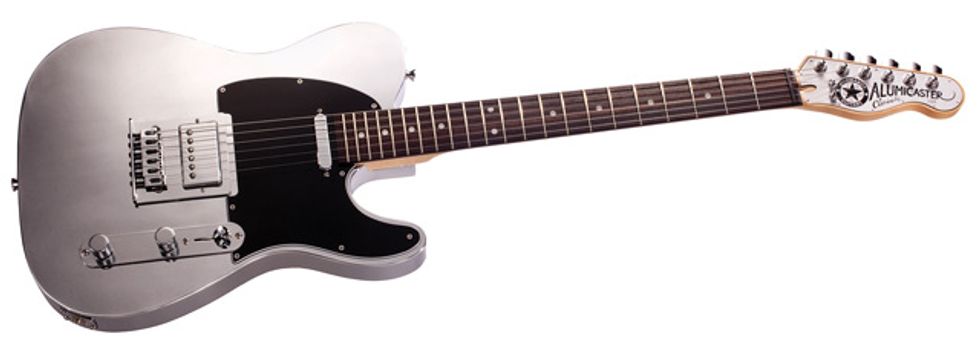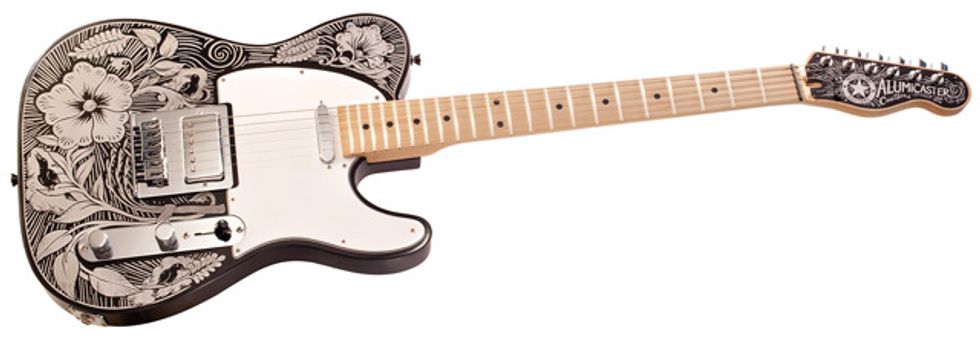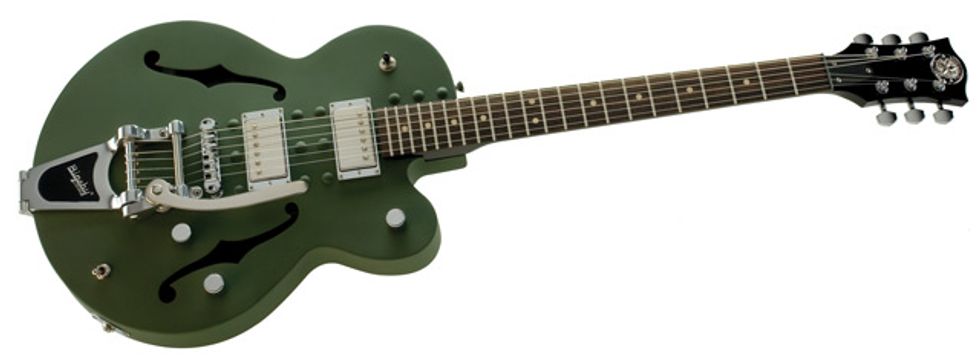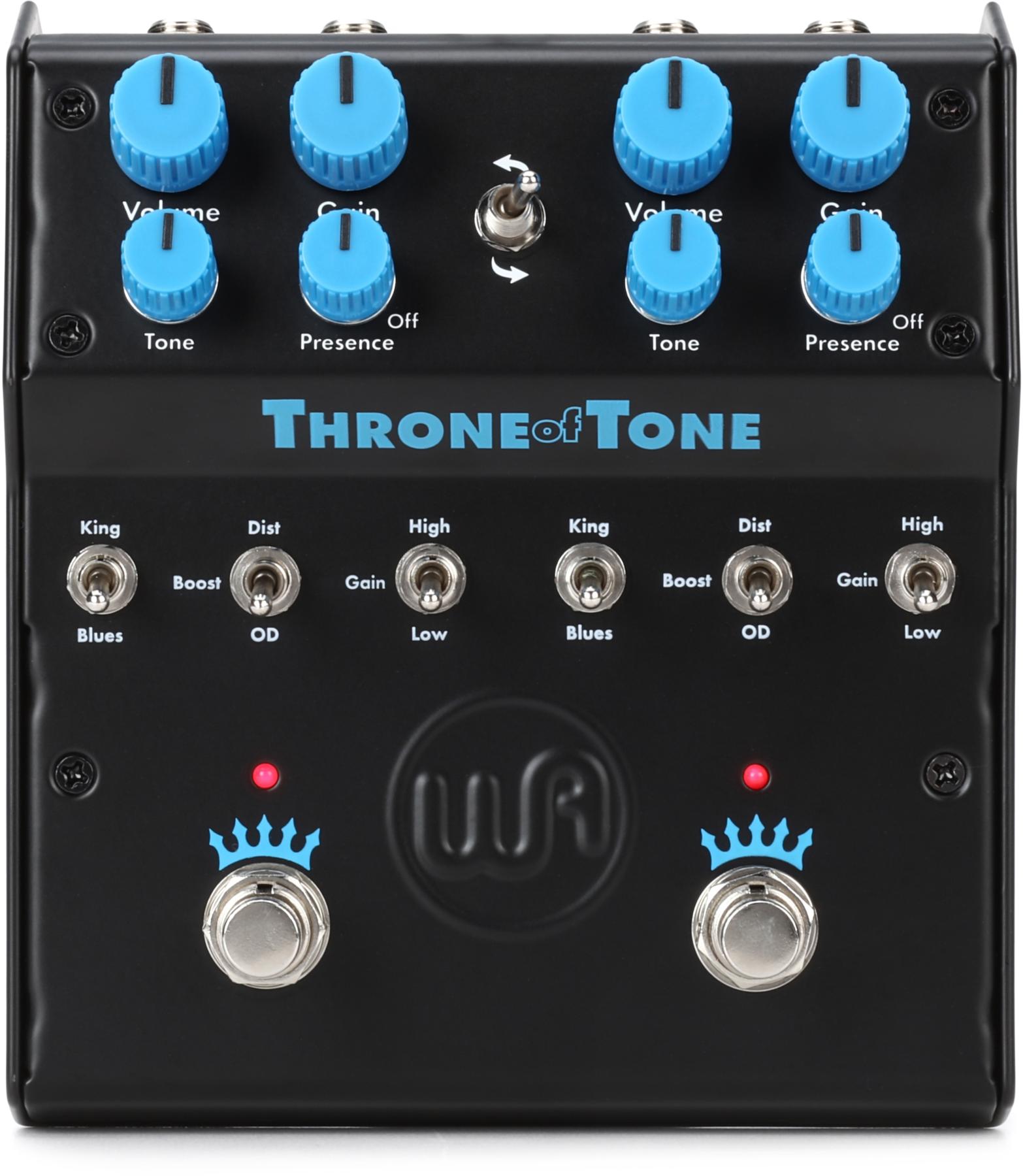"If it isn’t fun, we’re not fucking doing it," says Jim Normandy. This
was the motto that ultimately uprooted Normandy Guitars founder
and CEO out of the white-collared world of banking and placed him
in the land of luthiers. That and, of course, his love for guitars.
When Normandy was ensconced in the stringent corporate world, he
adopted different rules and alternative methods to get the job done.
So it’s no surprise that when he wanted to construct an acoustic bass
for himself 15 years ago, he thought of everything but wood. He considered
plastic, fiberglass, and other composite materials before landing
on aluminum. "After I dialed in the perfect thickness and grade
of aluminum, the instrument took on tonal characteristics all its own,"
Normandy says. "Aluminum is brighter and sustains longer than a
wood guitar. It also doesn’t feedback like wood."
Doing things different is one of Normandy’s quirks, but he insists it’s
not a gimmick. "Aluminum is much more consistent and dependable
than wood," Normandy says. "The designs for the guitars are
on a CAD machine, and we use lasers to cut out the aircraft-grade
aluminum so the consistency is spot-on every time we make a guitar."
Then, he welds the pieces together. Although Normandy acknowledges
that woodworking is an art form, he compares his use of aluminum
and lasers to what traditional builders do with wood and hand tools.
He feels that each time he makes a guitar, there’s that elusive X factor
that makes a guitar special.
Some purists may scoff at the idea of using aluminum, but Normandy
says every guitarist he’s gotten to strap on and plug in a Normandy
has been converted. "All I have to do is get it in a guitar player’s
hands and get them to play one and they’re hooked," he says. "They
might be skeptics beforehand, but once they hit those first few
chords, they realize it has that special tone mojo not found in wood."
Alumicaster
"Guitarists are creatures that can be easily weirded out," says
Normandy. "That’s why I keep a lot of the specs on the Alumicaster
very similar to that of the standard Telecaster." The aluminum body
is slab shaped and contoured very similarly to its wooden inspiration.
The body is hollow except for aluminum blocks under the neck
joint and the bridge that help transfer sound waves. The Alumicaster
comes standard with two Seymour Duncan pickups—a Custom
Custom humbucker in the bridge and a Hot Tele in the neck. It has a
four-screw, bolt-on hard rock maple neck and a rosewood fretboard.
Black Crow Engraved Alumicaster
This custom model features a black, anodized-aluminum body with
laser-cut floral and crow designs. The model shown here has the
same setup as a standard Alumicaster but has a maple fretboard
instead of rosewood.
Archtop
"When I crafted this instrument, I wanted to create something practical,"
says Normandy. "For a lot of players, big semi-hollow guitars
are too cumbersome and fat to allow a player comfort and a proper
reach." His Archtop model is about an inch wider at the lower bout
than a Les Paul, and it’s loaded with custom Normandy humbuckers
for high output and powerful midrange. It has a hard rock maple neck
and a rosewood fretboard. Although the large rivets on the guitar’s
face were initially for aesthetic appeal, they also hold the guitar
together. "I remember one day I pulled up next to this yellow
school bus and I saw those rivets and thought, 'Oh
yeah—those are badass and industrial.'"
Pricing and Availability
Normandy Alumicasters start at around $1500,
though prices vary depending on finish and other
options. The Archtop models range from $1999
to $3000. Normandy is also launching an
online custom shop where customers can
order custom finishes, necks, and electronics
at the level of detail exemplified
by the Black Crow Alumicaster.
normandyguitars.com
Normandy Guitars
Jim Normandy builds solidbodies and hollowbody guitars from aluminum.
By Chris KiesJul 20, 2010
Chris Kies
Chris Kies has degrees in Journalism and History from the University of Iowa and has been with PG dating back to his days as an intern in 2007. He's now the multimedia manager maintaining the website and social media accounts, coordinating Rig Rundown shoots (also hosting and/or filming them) and occasionally writing an artist feature. Other than that, he enjoys non-guitar-related hobbies.










![Rig Rundown: Russian Circles’ Mike Sullivan [2025]](https://www.premierguitar.com/media-library/youtube.jpg?id=62303631&width=1245&height=700&quality=70&coordinates=0%2C0%2C0%2C0)


























